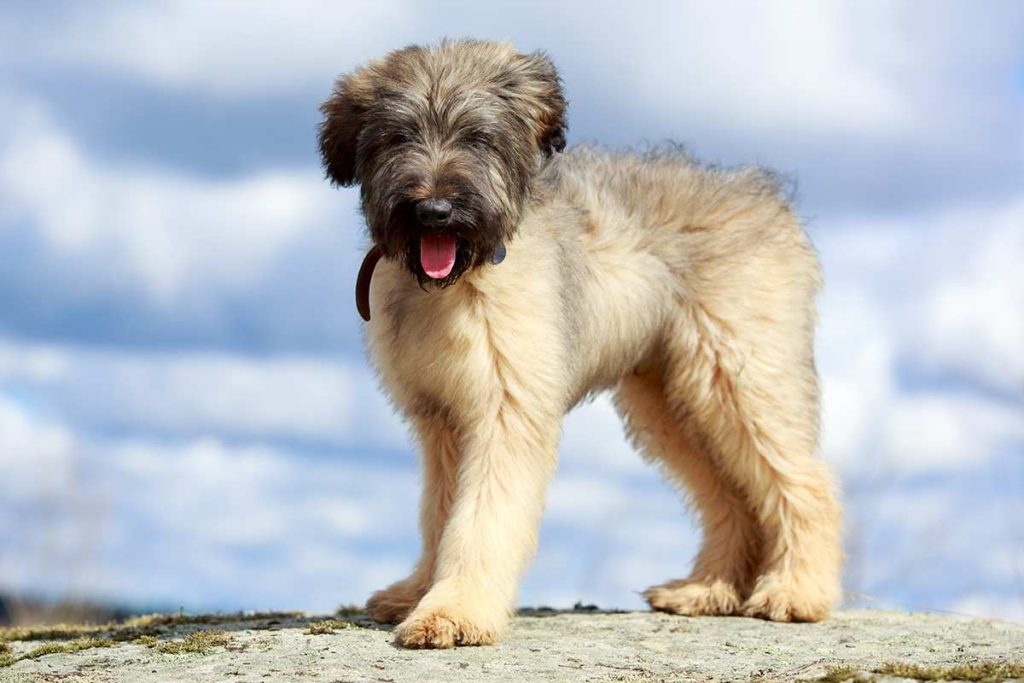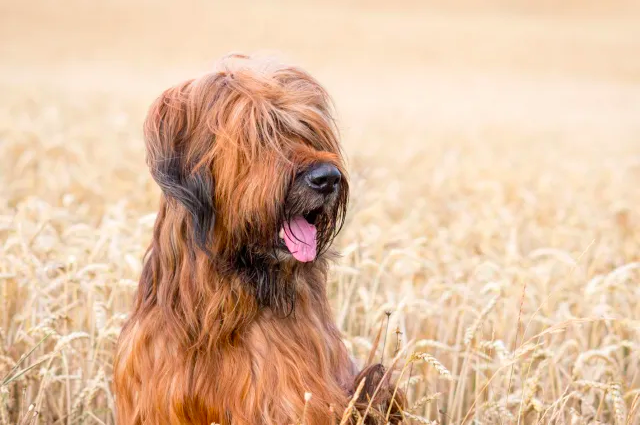Other names: Berger de Brie, Berger Briard.
The Briard is an ancient breed of large herding dogs, originally from France. A Briard-like dog appears in the illustrations in illuminated copies of Gaston Febus’ Livre de chasse (“Book of the Hunt”), written in the late 14th century. The breed became popular after the Paris dog show of 1863, after having been fixed with crosses with the Beauceron and the Barbet. During the First World War, the Briard was used, almost to the point of extinction, by the French army as a sentry and messenger, and to search for wounded soldiers. The Briard’s modern-day roles include police, military, and search-and-rescue work, as well as a companion dog.
History
They were originally bred to herd and guard flocks of sheep, and they were often left to their own devices to accomplish their assigned tasks. This makes the Briard different from those breeds that only guard and those that only herd. The breeds that just herd are often smaller in size, agile, and swift of foot. Those breeds that just guard are usually larger and heavier. Briards were used in all types of herding situations, having the ability to learn many commands and fulfill the jobs expected of them. The Briard was most commonly used as a farm dog in the more crowded farming valleys of France, where row crops were grown. Sheep were allowed to graze the grass strips between crops and Briards were responsible for keeping the sheep moving along these strips, and preventing the sheep from eating the crops. The Briard moved the sheep daily from the farm to the graze areas and back again at night. At the farm, the Briard was the shepherd’s partner, helping with livestock chores. The Briard was also used to move large flocks of sheep in areas of France that had wide grazing pastures and mountain pastures in summer. The Briards were usually worked beside one or two other breeds to keep the sheep from straying and herd the sheep to the proper areas. At night, they were alert and vigilant watchdogs, protecting the shepherds and flock from wolves and thieves.
According to legend, a Briard fought a judicial duel with Robert Macaire to avenge the murder of its owner, Aubry of Montdidier. Charlemagne, Napoleon, Thomas Jefferson, and Lafayette are all said to have owned Briards.
Appearance

The Briard can be tawny, black, grey, or blue, but variations in each colour can occur. Briards stand 58 to 69 cm (22 to 27 in) at the withers. Ear cropping has been common in the breed, although more breeders are leaving the ears in their natural state since ear cropping is becoming illegal in most European countries, including the Briard’s land of origin, France. When cropped, the ears should stand erect and parallel with the base being wide and tapering to a rounded point with hair covering the opening. Their long coats require extensive grooming. The outer coat is coarse, hard, and dry (making a dry rasping sound between the fingers). It lies down flat, falling naturally in long, slightly waving locks, having the sheen of good health. On the shoulders, the length of the hair is generally 15.24 cm (6.00 in) or more. The undercoat is fine and tight on all the bodies. The head is well covered with hair, which lies down, forming a natural part in the centre. The eyebrows do not lie flat but instead arch up and out in a curve that lightly veils the eyes. The hair is never so abundant that it masks the form of the head or completely covers the eyes. Briards exist in a variety of different colours.
The breed characteristics of the Briard are of a medium-sized, rugged, agile dog, having a harsh coat and double dewclaws mounted low on each rear leg, resembling additional toes. Each double dewclaw should have bone substance and nail, giving the appearance of a wider rear foot. Bred for centuries to herd, the additional digits on each rear foot give the Briard the ability to pivot on one foot for quick turns and complete turnarounds, which are necessary when herding and guarding their flocks. Throughout history, the Briard has retained an appropriate balance of size and build that is required for both herding and protection of their flocks. They are not too large to tire during herding, yet large enough to fend off predators such as foxes and wolves.
Temperament
The Briard is a very loyal and protective breed, and the breed has been called “a heart of gold wrapped in fur”. Once they have bonded with their family members, they are very protective. They can be aloof with strangers; new introductions should be on the dog’s terms, including furniture or the addition of a new baby into the household. They require showing that the new intrusion is friendly and free of conflict. They have proven to be a very good breed to have around children of all ages. These dogs are very emotional, capable of crying for a long time after their owners’ departure, and celebrate their return in a very enthusiastic way. As the Briard’s temperament is like many other working breeds, it is not suited for owners who “lack leadership skills, believe in giving in to every wish and desire of…pets or don’t have the time, energy, or commitment to bring out the best in a new Briard puppy.”
Introducing them to several different individuals of all ages and in all types of situations is also important. Socialization starting at a very young age is mandatory. Briards should be walked as often as possible, to many different places, so they develop into well-rounded animals.
Briards have been bred for centuries to herd and to protect their flocks. To domesticated dogs, their family is the flock and all strangers may appear to be predators.
Briards have a very good memory. Once a lesson is learned, good or bad, the knowledge is retained for a long time to come. Sometimes, they may appear to be strong-minded and stubborn, but these are a few of the Briard’s characteristics. They were bred for centuries to think for themselves and to act upon their conclusions, sometimes to the point of thinking what the “flock” will do ahead of time.
Even if a Briard is a city dweller, it has a degree of herding ability within. If ever, during its lifetime, it is introduced to sheep or cattle, it will automatically start doing what it was bred to do, herding. It will even herd humans by nibbling on their ankles or guiding with its head to guide them to its master if so ordered.
